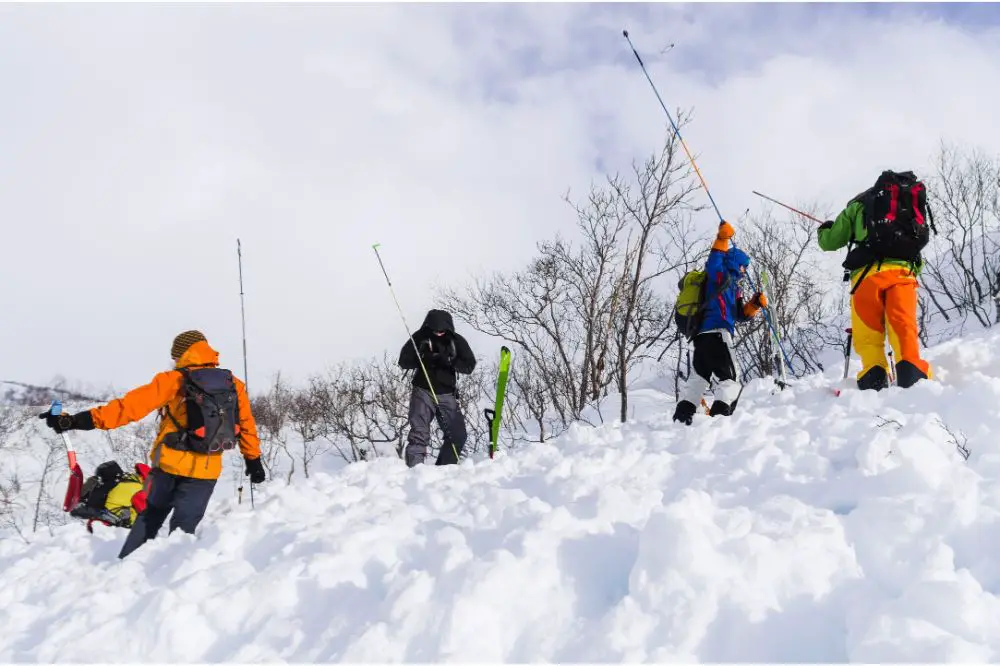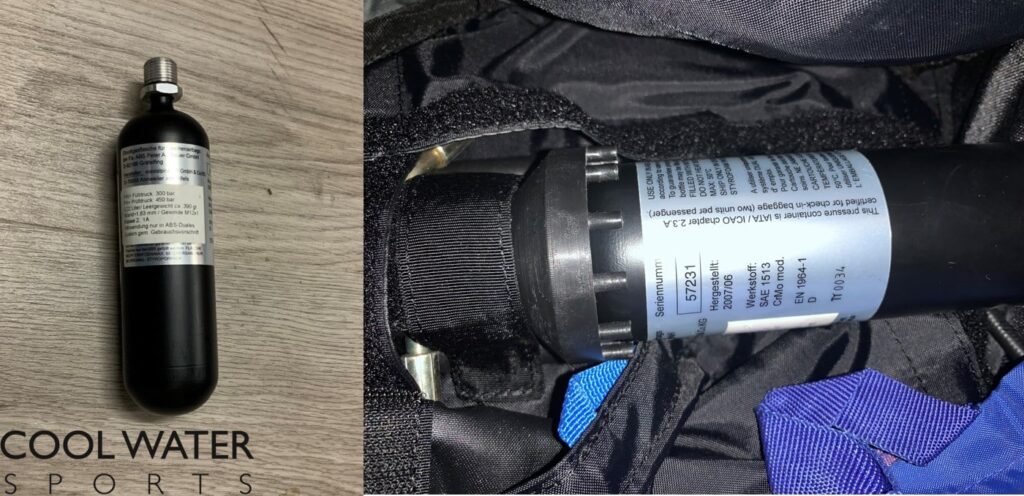Avalanche airbags are designed to protect you from avalanches, which are a major cause of death and injury in the mountains, by increasing the chance of keeping you on top if you get caught in an avalanche. But how do they actually work?

An Avalanche Airbag is a kind of backpack with integrated, inflatable bags. In case of an avalanche, the rider can inflate them fastly by pulling the release cord, increasing his overall volume (rider plus avalanche airbag). Due to a physical effect, which is elaborated more in detail later, larger items have a significantly increased chance to stay on top especially when the avalanche stops. Consequently, avalanche airbags help a rider to omit complete burial, increasing the chance of survival massively.
Therefore, avalanche airbags are not only used for freeride skiing and snowboarding but also for snowshoe hikers or climbers. Ultimately, they have been proven to save lives in the mountains.
In this article, we will explain to you what an avalanche is and what the dangers are, how avalanche airbags work in detail, why the airbags make you safer, and what they typically cost.
So read on to learn everything you need to know about staying safe when powder skiing!


What Is an Avalanche?
An avalanche is a type of mass movement that occurs when a large amount of snow or ice slides down a mountain at high speed, with or without an accompanying rockslide. Avalanches kill approximately 100-150 people worldwide annually, resulting in millions of dollars in property damage and losses. Snow avalanches are usually initiated when an accumulation of snow becomes heavy enough to overcome friction with the ground and start sliding downslope under gravity. The speed may vary but is typically between 5 and 57 m/s or 100-320 km/h.
Snow avalanches are a dynamic, active geological agent of erosion. They can be natural disasters, but they can also help to shape the landscape and create new features in the landscape. Avalanches are initiated by snow cover structural weaknesses, which often occur due to internal changes. These processes depend on dynamic and static conditions, including air temperature and wind speed. In contrast, static conditions include slope angle, height, and snow density (including wetting state).
Moreover, a single skier can also be responsible for causing an avalanche, as slight vibrations or movements can easily set off a slide. According to a survey, the victim triggers 90 percent of avalanche incidents involving people. Generally, large overburden of snow alone may not result in avalanching if it is anchored to a solid underlayer. In contrast, even a shallow snow layer can slide from the mountainside if poorly bonded. When additional weight and disturbance occur, friction and stabilization aren’t sufficient, and the snow starts to slide.
How Does an Avalanche Affect the Freeride Skier?
When an avalanche occurs, it can suck people into the snow and cause them serious injury or death. Generally, (avalanche) snow consists of snow crystals of various shapes and sizes. The small fragments or granules of snow rotate and crawl under the large volume during the process. They push the larger parts upwards to produce segregation dynamics in which the heavier parts sink back again.
However, when a snow slab is formed during an avalanche, the larger parts remain at the surface despite the weight. Likewise, if a Freerider is trapped in an unexpected avalanche, he goes through the same experience. First, the segregation effect pushes the person’s body upwards. Later, the lift dynamic is disrupted at a certain point, and the person instantly sinks into the heavy snow masses. Therefore, the Freerider is buried under the piles of snow due to the lack of a supporting surface, establishing a balance between his volume density and avalanche snow. And that’s how an avalanche airbag is intended to work: it increases the size of the freerider and therefore increases the chance to stay closer to the surface when the avalanche comes to a halt.
But why is it so important to stay on the surface?
According to statistics, 93 percent of avalanche victims survive if dug out within 15 minutes. As a consequence: the airbags help to stay on the surface and oftentimes ensure that the victim is not completely buried, which makes finding and rescuing not only easier but much faster.
If you’re a freeride skier, you know how important it is to stay safe. An avalanche can happen without warning, and the effects of an avalanche can be devastating besides the risk of getting buried: You can get injured by dragging the slope at high speeds downwards and hitting obstacles like stones, trees, etc. It can cause serious injuries such as broken bones, internal bleeding, or cervical spine fractures with dislocation that can lead to death.
Nevertheless, the chance to survive until the avalanche stops are comparably high. But when it stops and you are completely buried, you can die through suffocation, carbon dioxide poisoning, or hypothermia. Suffocation happens because your body cannot release the air trapped in your lungs due to pressure from the snow above it. You can also breathe out carbon dioxide, which can lead to carbon dioxide poisoning. The warm breath will also melt snow and create a solid layer of ice that oxygen cannot penetrate easily. And of course, getting trapped below a huge mountain of snow can cause hypothermia.
That’s why it’s important to have an avalanche survival kit with you when out in snowy conditions so that you don’t get buried alive by an avalanche! Luckily, if the Freerider or victim immediately activates his avalanche airbag, he can avoid such an incident and survive the disaster.

How Do Avalanche Airbags Work?
The Avalanche Airbag System (ABS) is a self-inflating and self-deploying inflatable device that protects burial by snow or ice during an avalanche. The device uses compressed gas (nitrogen or oxygen), typically stored at high pressure in a cylinder inside the ABS, to inflate a protective bag around an individual.
Every avalanche airbag contains a single-bag or twin-bag system that consists of one or two inflatable bags that are positioned side by side and inflated at the same time. The bags are connected with a tube to a gas cylinder. The gas cylinder is typically located at the top of the backpack, roughly in the shoulder area of the wearer. The backpack has a removable release handle. If this is pulled by the rider, the bags are inflated by means of the gas pressure from the gas cylinder within a few seconds.


As explained above, they increase the size of the freerider and therefore increase the probability to stay on the surface of the avalanche as it stops. Avalanche airbags were originally designed for military purposes but have also been adapted for civilian use. Most Avalanche Airbag Systems do not require any external power source for operation except those which work with battery-powered fan systems.
Do They Really Help in Case I Get Caught in an Avalanche?
Initially, the idea of using an airbag was considered impractical because it would take too long to inflate. However, studies have shown that these devices decrease the risk that the rider gets buried completely and can either save himself or help rescuers locate victims much faster. But it is important that the many important features of avalanche airbags that make them safe and effective are manufactured in high quality.
A reliable Avalanche Airbag needs to be made with high-quality materials that are durable, strong, and reliable. Ideally, the device also has an emergency beacon that sends out SOS signals when activated by the user. Eventually, the GPS tracker helps detect the user’s location and alerts rescuers. However, this should not waive on wearing a separate Avalanche beacon.
When an avalanche occurs, the victim is pulled down by the weight of the snowpack. The victim is thrown down the slide until it’s at least waist-deep. It is certainly the point when they must pull a ripcord to activate their airbag, which inflates within 3 seconds and keeps them on top of the snowpack. By the way: the non-inflation rate (cases in which an avalanche victim was not able to inflate the airbag and got buried) is about 20% of which 60% can be attributed to a deployment failure of the rider! So the tagline should be: it is better to pull the cord one time too often than one time too less!
In 2012, Elyse Saugstad survived an avalanche on Stevens Pass in Washington State that swept professional skier Elyse Saugstad more than 600 meters in 30 seconds. She credits her airbag with keeping her head above the snow slide, which killed three other skiers in her group.
What Do Avalanche Airbags Cost?
The cost of avalanche airbags can vary depending on the brand, size, and features that you want. For instance, the Ortovox Ascent Avabag Kit costs $644, whereas the Black Diamond Jetforce Tour Airbag costs around $1300. Yes, they cost a significant amount of money, but the price of an avalanche airbag is much less than the trauma and suffering that people go through while trapped.
Therefore, it is worth the money in the long run if you regularly ski in the backcountry.
Ortovox Ascent Avabag Kit
Black Diamond Jetforce Tour Airbag
Conclusion
Avalanche airbags are worth the investment as they have the potential to save lives. However, they do not offer 100% safety, which means that the ultimate goal must be to never have to use it. The situational judgment of the avalanche situation and assessment of the risk you have to learn and practice despite an avalanche backpack.
Properly applied and used, they are not only an important safety instrument, they are also practical, because you can store all your freeride equipment inside. And if you choose a good quality product and follow the maintenance instructions, you can use the airbag for years and enjoy carefree fun in the powder.
